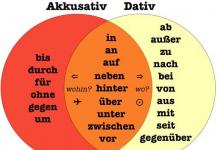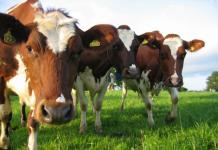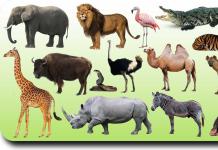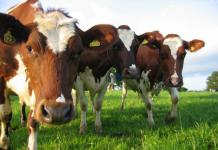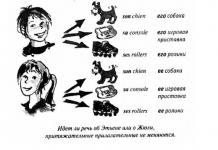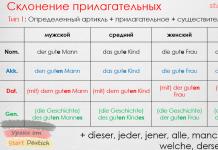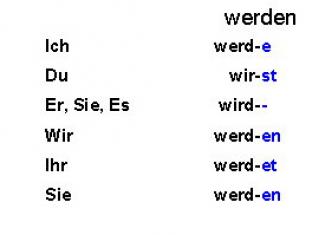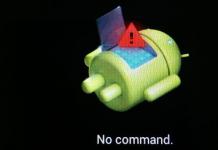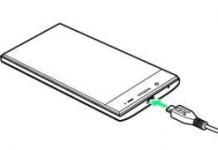Unlike a noun, where each noun refers to a particular type of declension, the adjective as a definition can only be inclined by strong or weak type of declension... The type of declension depends on the composition of the vocabulary in which the adjective occurs.
Weak declination adjectives are declined in the following vocabulary combinations:
1. In the singular after the definite article der, die, das or the demonstrative pronoun dieser (dieses, diese).
Plural after alle, beide, sämtliche, negative pronoun kein and possessive pronouns.
| Maskulinum | Femininum | |
| Nom | der (dieser) gut e Freund | die (diese) rot e Ampel |
| Gen | des (dieses) gut ru Freundes | der (dieser) rot ru Ampel |
| Dat | dem (diesem) gut ru Freund | der (dieser) rot ru Ampel |
| Akk | den (diesen) gut ru Freund | die (diese) rot e Ampel |
| Neutrum | Im Plural | |
| Nom | das (dieses) neu e Auto | alle (meine) neu ru Autos |
| Gen | des (dieses) neu ru Autos | aller (meiner) neu ru Autos |
| Dat | dem (diesem) neu ru Auto | allen (meinen) neu ru Autos |
| Akk | das (dieses) neu e Auto | alle (meine) neu ru Autos |
2. After the indefinite article ein, eine, the negative pronoun kein and possessive pronouns(singular).
| Maskulinum | Femininum | Neutrum | |
| Nom | ein (mein) gut er Freund | eine (Ihre) grün e Wiese | ein (mein) neu es Auto |
| Gen | eines (meines) gut ru Freundes | einer (Ihrer) grün ru Wiese | eines (meines) neu ru Autos |
| Dat | einem (meinem) gut ru Freund | einer (Ihrer) grün ru Wiese | einem (meinem) neu ru Auto |
| Akk | einen (meinen) gut ru Freund | eine (Ihre) grün e Wiese | ein (mein) neu es Auto |
3. In units. hours without accompanying words.
In pl. h without accompanying words and after cardinal numbers.
| Maskulinum | Femininum | |
| Nom | warm er Kaffee | warm e Milch |
| Gen | warm ru Kaffees | warm er Milch |
| Dat | warm em Kaffee | warm er Milch |
| Akk | warm ru Kaffee | warm e Milch |
| Neutrum | Im Plural | |
| Nom | kalt es Wasser | kühl e Tage / drei schwarz e Katzen |
| Gen | kalt ru Wassers | kühl er Tage / drei schwarz er Katzen |
| Dat | kalt em Wasser | kühl ru Tagen / drei schwarz ru Katzen |
| Akk | kalt es Wasser | kühl e Tage / drei schwarz e Katzen |
Table "Declination of adjectives in German"
Exercises on the topic "Declination of adjectives in German" / ÜBUNGEN
1. Read, determine the gender and case of the adjectives in bold. Translate these sentences.
2. Read the following text, inserting the appropriate adjective endings.
Im Zug
Es ist ein schön__, warm__ Tag. Der Zug fährt nach Berlin. Auf einer klein__ Station setzt sich ein neu__ Fahrgast neben einen solid__ Herrn und fragt ihn:
- Fahren Sie auch nach Berlin?
- Nein.
- Dann fahren Sie nach Leipzig?
- Ja.
- Fahren Sie auf Urlaub?
- Nein.
- Dann ist das eine kurz__ Dienstreise?
- Ja.
- Was sind Sie von Beruf?
Da sagt der Nachbar ärgerlich:
- Mein Herr, ich bin Ingenieur. Ich bin 42 Jahre alt und bin ein Meter 78 groß. Schuhgröße 41. Mein Vater lebt nicht mehr, meine Mutter ist 68 Jahre alt. Ich bin verheiratet. Meine Frau ist Ärztin. Im nächsten Monat wird sie 40. Wir haben zwei schön__ Kinder: eine vierzehnjährig__ Tochter und einen zehnjährig__ Sohn. Wir haben ein groß__ Eigenheim mit einer groß__ Garage. Das Haus steht in einem klein__ Garten. Wir haben einen modern__ Wagen. Ich trinke heiß__ Tee mit Zucker gern. Wollen Sie noch etwas wissen?
Alle Fahrgäste lachen. Aber der neu__ Fahrgast fragt:
- Ich möchte gern noch wissen: wie heißen Sie?
- Ich habe einen kurz__ Namen: ich heiße Lang.
German grammar:
Declination of adjectives
The adjective plays an auxiliary role in the declension of the noun. In combination "article + adjective + noun" should be one grammatically expressive ending, which characterizes the gender, number, case of a noun, therefore the declension of an adjective depends on which article or pronoun the noun is used with. If the article or pronoun has an expressive case ending, then the adjective gets a neutral ending (-e or -en). If the article has no ending (for example, the article ein for masculine and neuter), or a noun is used without an article, then the adjective gets a significant ending.
There are three types of declension of adjectives: strong, weak and mixed.
Strong declension (no article)
If a noun is used without an article or pronoun, then the adjective takes on the function of the article and receives the endings of the definite article (except for the endings in the masculine and neuter genitive, where the adjective has a neutral ending -en since the noun itself has a significant ending).
| Singular | |||
|---|---|---|---|
| masculine gender | neuter gender | feminine | |
| Nom. | gut er Kaffee | frisch es Brot | warm e Milch |
| Gen. | gut ru* Kaffee s | frisch ru* Brot s | warm er Milch |
| Dat. | gut em Kaffee | frisch em Brot | warm er Milch |
| Akk. | gut ru Kaffee | frisch es Brot | warm e Milch |
Weak declension (after the definite article)
- After the definite article, and
- after pronouns dieser, jener, jeder, solcher, welcher, mancher declining like a definite article,
the adjective gets a neutral ending -e with the initial form of the article (as in the nominative), and the ending -en with the changed form of the article.
| Singular | |||
|---|---|---|---|
| masculine gender | neuter gender | feminine | |
| Nom. | der alt e Mann | das klein e Kind | die jung e Frau |
| Gen. | des alt ru Manns | des klein ru Kindes | der jung ru Frau |
| Dat. | dem alt ru Mann | dem klein ru Kind | der jung ru Frau |
| Akk. | den alt ru Mann | das klein e Kind | die jung e Frau |
Mixed declension (after the indefinite article)
Mixed declination of the adjective
- after the indefinite article,
- pronouns kein,
- possessive pronouns ( mein, dein, unser, euer etc.).
There is only mixed declension in the singular, since there is no indefinite article in the plural, and possessive pronouns and "kein" are inflected in the plural as a definite article (hence, adjectives after them are inflected weakly).
The indefinite article and the indicated pronouns do not have a significant grammatical ending in the masculine nominative, as well as in the neuter nominative and accusative, so here the adjective takes a significant (generic) ending. In other cases, the indefinite article is declined in the same way as the definite, therefore the adjective has the same endings ( -e or -en) as after a definite article.
| Singular | |||
|---|---|---|---|
| masculine gender | neuter gender | feminine | |
| Nom. | ein (unser) neuer Wagen | ein (unser) kleines Haus | eine (unsere) groß e Familie |
| Gen. | eines (unseres) neu ru Wagens | eines (unseres) klein ru Hauses | einer (unserer) groß ru Familie |
| Dat. | einem (unserem) neu ru Wagen | einem (unserem) klein ru Haus | einer (unserer) groß ru Familie |
| Akk. | einen (unseren) neu ru Wagen | ein (unser) kleines Haus | eine (unsere) groß e Familie |
Declension of adjectives in plural
In the plural, only two types of declension are distinguished:
| Strong declination | |||
|---|---|---|---|
| The adjective has case endings in the absence of an article, as well as after indefinite pronouns (which are also declined): viele(many) einige(several) mehrere(several) wenige(few) |
Nom. | viel e(einig e, wenig e) | alt e Freunde |
| Gen. | viel er(einig er, wenig er) | alt er Freunde | |
| Dat. | viel ru(einig ru, wenig ru) | alt ru Freunden | |
| Akk. | viel e(einig e, wenig e) | alt e Freunde | |
| After pronoun manche(some) adjective endings are both strong and weak: | manche alt e/ alt ru Bücher | ||
| Weak declension | |||
| The adjective has an ending -en after the accompanying words: alle(all) beide(both) keine meine(deine, unsere, etc.) welche(what kind) solche(such) diese(these) die |
Nom. | di e(all e, mein e, unser e) | alt ru Freunde |
| Gen. | d er(all er, mein er, unser er) | alt ru Freunde | |
| Dat. | d ru(all ru, mein ru, unser ru) | alt ru Freunden | |
| Akk. | d ie(all e, mein e, unser e) | alt ru Freunde | |
- If a noun is preceded by two or more adjectives, then they all have the same endings, for example: eine groß e, schwer e Arbeit; mit gut ru alt ru Freunden
- Ordinal numbers and participles as definitions are declined as adjectives: am sechst ru Dezember, die geputzt ru Schuhe
Without adjectives, any speech will be dry and expressionless. It is this part of speech that helps to describe objects, and in German adjectives have their own characteristics, which you will learn about in this lesson.
So, an adjective is a part of speech that denotes a quality or property of an object and changes in cases, numbers and gender. The adjective answers the questions "welcher?" - what ?, "welches?" - what ?, "welche?" - what ?, "was für ein?" - which the? In German, an adjective is inflected when it precedes a noun.
There are three types of adjective declensions in German:
1. Strong declination;
2. Weak declination;
3. Mixed declension.
Let's consider the features of each of them.
Strong declension of adjectives (Starke Deklanation)
According to the strong type of declension, adjectives change without an article. Study the table carefully:
Singular
| Masculine gender | Neuter gender | Feminine | |
|---|---|---|---|
| Nom. | guter Kaffee | gutes Brot | gute Butter |
| Gen. | guten Kaffee | guten brot | guter Butter |
| Dat. | gutem Kaffee | gutem brot | guter Butter |
| Akk. | guten Kaffee | gutes Brot | gute Butter |
As you can see, adjectives get the same endings as the definite article - the only exceptions are the masculine and neuter genitives: the ending "en" appears here. Without an article, the adjective takes on the function of distinguishing case, and that is why it changes as shown in the table.
Plural adjectives, as you might have guessed, behave the same way:
Plural
In the plural, adjectives receive the plural endings of the definite article. However, it is important to remember that the indefinite pronouns in front of them receive the same endings. These pronouns include:
viele (many)
einige (some, few)
mehrere (several)
wenige (little, little)
manche (some, many)
Don't confuse "viel" and "viele"! Very often, where "many" (viele) is used, we are used to saying "many" (viel). For example: Sie isst zu viel - She eats too much. Er hat viele Freunde. - He has a lot of friends.
Weak declension of adjectives (Swache Deklanation)
If there is a definite article in front of the adjectives, then they change according to the weak type of declension. The mixed type is a combination of the previous two types, because some of the case endings coincide with the endings of the weak type of declension, and some - with the endings of the strong one.
Singular
| Masculine gender | Neuter gender | Feminine | |
|---|---|---|---|
| Nom. | der gute Tag | das gute Kind | die gute Frau |
| Gen. | des guten Tag | des guten Kind | der guten Frau |
| Dat. | dem guten Tag | dem guten Kind | der guten Frau |
| Akk. | den guten Tag | das gute Kind | die gute Frau |
As you can see, there are very few endings: "e" and "en". Moreover, the adjective receives the ending "en" in the case when the ending of the article also changes.
With the plural, everything is also easy. Only the ending "en" is used here:
Plural
Nom. guten Freunde
Gen. guten Freunde
Dat. guten Freunde
Akk. guten Freunde
Adjectives change according to the weak type of declension in the following cases:
after a definite article;
demonstrative pronouns dieser (this), jener (that);
after indefinite pronouns jeder (each);
after the pronouns alle (all), solche (such), beide (both);
after the interrogative pronouns welche;
after the negative pronoun keine;
after possessive pronouns.
Mixed declension (Gemischte Deklination)
This type of declension is relevant only for adjectives in the singular. This can be explained simply: adjectives are used with an indefinite article, but the indefinite article does not have a plural form.
| Masculine gender | Neuter gender | Feminine | |
|---|---|---|---|
| Nom. | ein guter Tag | ein gutes Kind | eine gute Frau |
| Gen. | eines guten Tag | eines guten Kind | einer guten Frau |
| Dat. | einem guten Tag | einem guten Kind | einer guten Frau |
| Akk. | einen guten Tag | ein gutes Kind | eine gute Frau |
In the weak declension, adjectives change after the indefinite article, possessive pronouns and after kein.
Lesson assignments
Exercise 1. Decline phrases.
Unit: der kluge Mann, jenes gute Kind, junge Frau
Mn. number: die guten Eltern, schöne Häuser, deine nahe Freunde
Exercise 2. Choose viel or viele.
1. Sie liest…. 2. Sie haben…. Verwandte. 3. Da sind ... Studenten. 4.… Leute kamen zur Party. 5. Auf dem Tisch gibt es ... Bücher. 6. Meine Schwester isst nicht….
Answer 1.
Unit number:
Answer 2.
1.viel 2.viele 3.viele 4.viele 5.viele 6.viel
Declining adjectives in German is easy! To do this, you need to know three tables and three steps. We will tell you about a method that will surely help you form the correct ending of any adjective.
A video version of this article for those who like to watch and listen more than read
Step 1: Determine the table number to use
- If the article definite, then you need to look at the first table.

According to the rules of the first table, adjectives with dieser, jeder, jener, alle, manche, solche, welche, derselbe, beide.
- If the article uncertain, then you need to look at the second table.

According to the rules of the second table, adjectives with kein.
- If the article zero (absent), then you need to look at the third table.

According to the rules of the third table, adjectives with andere, einige, etliche, folgende, mehrere, verschiedene, viele, wenige.
Step 2: Determine the Table Column by the Gender of the Noun
Here, too, everything is simple:
If the noun is masculine, then you need to look in the first column, if the middle one, then in the second, and so on. There is a separate column for the plural, don't forget!
Step 3: Determine the table row by case
It's a little more complicated here, because we need to determine the case in which the noun stands. Having determined the case, we can find the required row in the table, and then - the cell. Taking the correct example from the cell, we will inflect the noun and adjective in its likeness.
Let's see one example: Das Dreirad gehört (das, klein) Kind.- The tricycle belongs to a (small) child.
Step 1: Since the article is definite, we need the first table:
Step 2: We are looking for the required column. Because das Kind neuter, we need a second column.
Step 3: We are looking for the required string, determining the case. gehören + Dativ - to belong to someone, this German verb, like its Russian counterpart, requires the dative case after itself. This means that we need a third line.
So, the cell has been found. Now let's inflect by substituting words in a sentence: Das Dreirad gehört dem kleinen Kind.
Ready! Simple, isn't it?
One more example: Wir haben (ein, spannend) Film gesehen.- We saw a (interesting) movie.
Step 1: Since the article is indefinite, we need a second table:

Step 2: We are looking for the required column. Because der Film masculine, we need the first column.
Step 3: We are looking for the required string, determining the case. Wir haben (ein, spannend) Film gesehen. - We watched an interesting film. To determine the case, we ask a question. Did you see what? - movie. This is the accusative case, Akkusativ. Therefore, we need the second line.
The second row, the first column, is einen guten Mann. Transferring to our example, we get: Wir haben einen spannenden Film gesehen.
Ready! I think you have now learned how to inflect adjectives and are ready to complete the exercises to consolidate the topic.
Download exercises for declension of adjectives according to the first table with answers
Download exercises for declension of adjectives according to the second table with answers
Valeria Zakharova,
Adjectives in German are declined if and only if they come before a noun:
Red th table - rot er Tisch
red oh table - rot em Tisch
There are three types of declension of adjectives:
- Strong declination.
- Weak declination.
- Mixed declension.
- If the adjective comes before a noun without an accompanying word, then it is inflected in a strong type.
- If there is an accompanying word, but it ambiguously shows gender, number and case, then the adjective is declined in a mixed type.
- If there is an accompanying word and unambiguously shows gender, number and case, then the adjective is declined according to the weak type.
Strong declination
IMPORTANT!
In the plural, words: Viele (many), Einige (several), Wenige (few), Zweie, dreie usw (two, three, etc.) acquire a generic / case ending and do not affect the ending of the adjective ( both parts of speech receive a definite article ending):
Viel e gut e Eltern (Nom.) - many good parents
Viel e gut e Eltern (Akk.) - many good parents
Wenig ru gut ru Eltern (Dat.) - Few Good Parents
Einig er gut er Eltern (Gen.) - some good parents
Weak declension of adjectives

IMPORTANT!
1. In the plural, after the words alle (all), sämtliche (meaning alle) and beide (both) in all cases, the adjectives get a neutral ending<-en>, with alle and beide also receiving the plural ending (the definite article ending).
Alle mein ru Freunde (Nom.)
Alle dein ru Freunde (Akk.)
All ru dein ru Freunde (Dat.)
All er sein ru Freunden (Gen.)
2. The definite article, demonstrative pronoun and interrogative pronoun are mutually exclusive parts of speech and are not used simultaneously with the same noun:
Der gute Vater - Diese gute Mutter (correct)
Der dieser gute Vater - Jede die gute Mutter ( not right)
3. Different parts of speech can act as an accompanying word, but all of them unambiguously show the gender and number of the noun already in the Nominativ.

NOTE!
In compound demonstrative pronouns (derselbe, derjenige ...) the definite article is merged with the demonstrative word, which means that both parts of the word are declined. In this case, the part-article is declined as a definite article, and the part-adjective, as an adjective:
D er selb e gut e Film is the same good film
D ie selb ru gut ru Filme - the same good films
Mixed declension

IMPORTANT!
The indefinite article EIN is not used in the plural.
Declension of homogeneous adjectives
Homogeneous adjectives preceding a noun are inclined in the same way:Ein klein es neu es Haus / Das klein e neu e Haus
Klein e neu e Häuser / Die klein ru neu ru Häuser
Declension of compound adjectives
When an adjective consists of several (it is a plural or compound word), the ending is placed only at the end of the word:Mathematisch-naturwissenschaftlich es Thema - strong declension
das mathematisch-naturwissenschaftlich e Thema - weak declension
ein mathematisch-naturwissenschaftlich es Thema - mixed declension
Declination of adjectives before substantive adjectives
If in a sentence the adjective describes a substantive adjective (Der Deutsche, Die Kranke, Die Verwandten), then the end of the definition is selected according to the general rule: either the adjective itself (definition) or the word accompanying it must determine the gender, number and case of the noun. Gender, number and case are shown in a phrase once. In this case, the substantivized adjective receives neutral endings<-е>or<-еn>:Der Kranke - Sick
Der arm e Krank e- poor patient
Ein e arm e Krank e- (some) poor patient
ein es arm ru Krank ru(Genitiv, "Whose?") - one poor patient (m)
ein er arm ru Krank ru(Genitiv, "Whose?) - one poor patient (f)
Exception! Singular Dativ. If the gender shows an adjective (that is, we have a strong declension), then the substantivized form will have a neutral ending:


